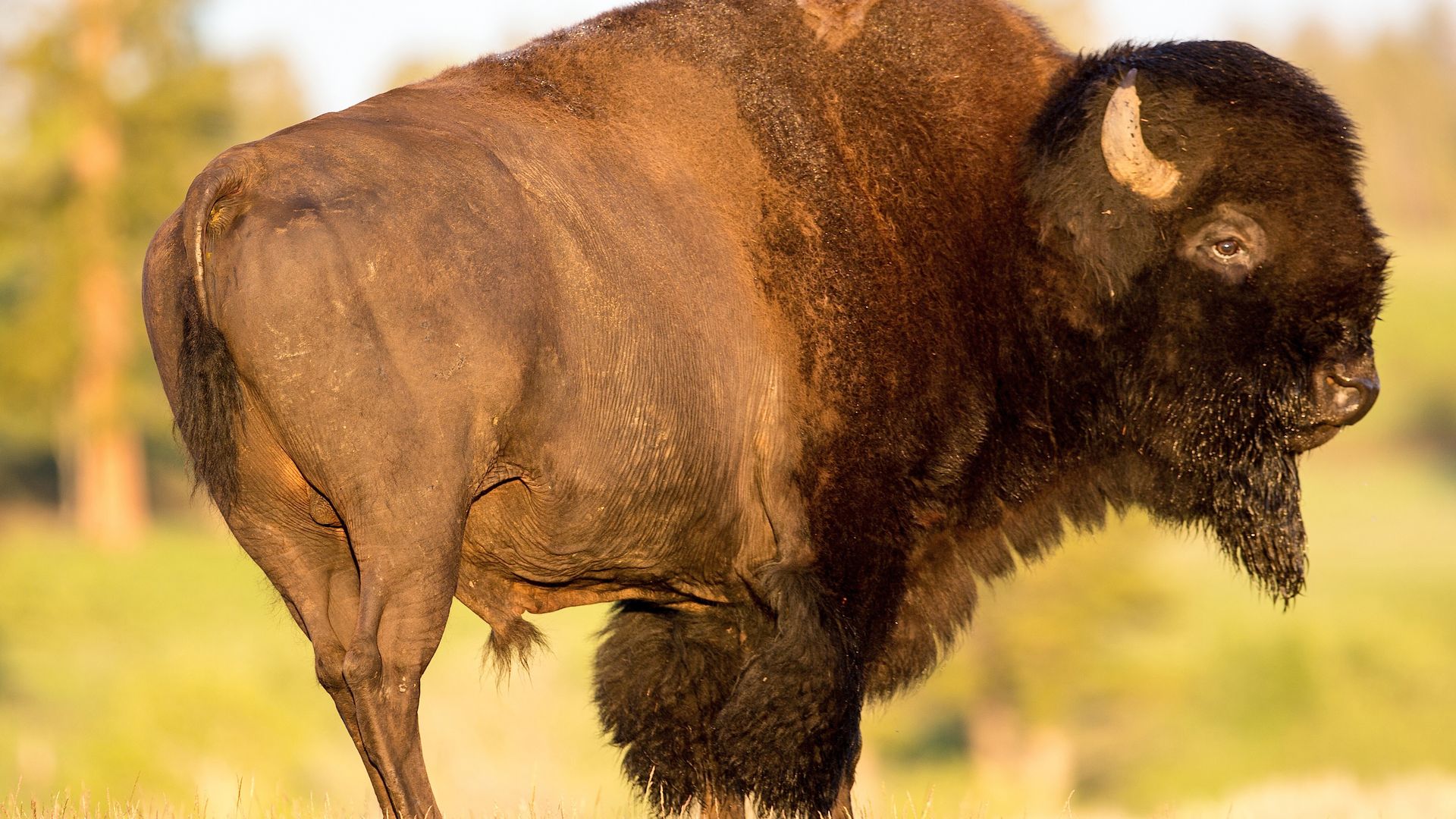
KARAH RUCKER: IT’S AN ICON OF THE WEST. THE AMERICAN BISON. BUT EVEN AFTER THIS ANIMAL WAS BROUGHT BACK FROM THE BRINK OF EXTINCTION – THE SPECIES CONTINUES TO FACE CHALLENGES. THE LATEST – A GRUESOME HUNT THAT’S RAISING QUESTIONS ABOUT WHAT’S BEST FOR NATIVE TRIBES – AND THE CONSERVATION OF THE SPECIES.
EVERY WINTER BISON FROM YELLOWSTONE NATIONAL PARK HEAD TO LOWER GROUND IN SEARCH OF FOOD. THEY MIGRATE NORTH AND WEST, INTO THE STATE OF MONTANA, WHERE THEY BECOME FAIR GAME FOR HUNTERS.
THIS WINTER, MORE THAN 15-HUNDRED BISON WERE KILLED – A RECORD NUMBER. MAINLY BY INDIGENOUS TRIBES WHICH HAVE THE RIGHT TO HUNT THE BISON UNDER HISTORIC TREATIES. TO PUT IT IN PERSPECTIVE, LAST YEAR, ONLY 56 YELLOWSTONE BISON WERE HARVESTED.
NOW THE U.S. FISH & WILDLIFE SERVICE IS IN THE MIDST OF A 12-MONTH ‘THREAT ASSESSMENT’ TO DETERMINE WHETHER YELLOWSTONE BISON NEED TO BE LISTED FOR PROTECTION UNDER THE ENDANGERED SPECIES ACT.
IT’S A COMPLICATED ISSUE THAT INVOLVES STATE AND FEDERAL AGENCIES. AND IT’S MADE WORSE BY BAD OPTICS. AS THE BISON MIGRATED NORTH INTO PUBLIC FOREST LAND, THEY WERE KILLED NEAR PEOPLE’S HOMES AND MOTORWAYS. SOME OF THE SLAUGHTERED WERE PREGNANT FEMALES. SO FETUSES AND ENTRAILS WERE LEFT BEHIND TO LITTER THE LANDSCAPE.
MORGAN JACOBSEN | INFORMATION OFFICER FOR MONTANA FISH, WILDLIFE AND PARKS IN SOUTHWEST MONTANA: “The state of Montana doesn’t regulate the number of bison that tribal hunters can harvest or what their season dates are, things like that. Those are largely determined by each individual tribe.”
THE PRESERVATION OF YELLOWSTONE BISON IS IMPORTANT BECAUSE THEY ARE SPECIAL. THEY ARE TWO GENETICALLY DISTINCT HERDS. BUT ONCE THEY MIGRATE INTO MONTANA, THEY BECOME THE RESPONSIBILITY OF THE STATE. MORGAN JACOBSEN IS AN INFORMATION OFFICER FOR MONANTA’S FISH, WILDLIFE, AND PARKS:
JACOBSEN: “A lot of this collaboration and communication happens through what’s called the Interagency Bison Management Plan. And so this is an interagency group of federal and state and tribal entities that come together to look at solutions for managing bison outside of the park.”
TOM WOODBURY | DIRECTOR OF COMMUNICATIONS FOR BUFFALO FIELD CAMPAIGN: “It cannot be any more clear that the system that is called the Interagency Bison Management Plan, which was entered into in 2000, is totally broken. And Montana is just using it to interfere with the hunt with the tribal harvest or exercise of treaty rights.”
FOR THE LAST 20 YEARS, TOM WOODBURY HAS BEEN AN ADVOCATE FOR FREE ROAMING BUFFALO ACROSS THE YELLOWSTONE ECOSYSTEM. HE SAYS MONTANA IS NOT INTERESTED IN PRESERVING THE YELLOWSTONE BISON.
WOODBURY: “The state of Montana does not consider our national Mammal to be a wildlife species, they consider buffalo to be a diseased species in need of management.”
JACOBSEN ADMITS THAT THE IBMP MEETS SEVERAL TIMES A YEAR TO DISCUSS MANY THINGS, INCLUDING HOW TO REDUCE THE RISK OF BRUCELLOSIS – A TRANSMISSIBLE DISEASE THAT CAN CAUSE BISON AND CATTLE TO ABORT THEIR BABIES. CULLING BISON IS A WAY TO REDUCE THAT RISK.
MARTIN ZALUSKI | MONTANA STATE VETERINARIAN 08:42: “We have been successful in eradicating Brucella abortus from cattle. So you would have animals on the landscape that are that don’t have the disease and then if you graze them with animals that do have the disease that have the symptoms that have abortions, then obviously there will be an exposure like we’ve seen in this state for you know, the for over 15 years, that where there are infections from infected wildlife.”
MARTIN ZALUSKI IS MONTANA’S ANIMAL HEALTH OFFICIAL. HIS MAIN ROLE IS TO PROTECT THE STATE’S LIVESTOCK FROM DISEASE.
ZALUSKI: “The intersection between the bison population and brucellosis is that because of the value of Yellowstone National, Yellowstone, bison, people would like to see those bison translocated to other parts of the country, rather than, you know, shipped to slaughter or potentially even hunted. But no other state is willing to accept bison that are infected with brucellosis because they don’t want to put their own animal health in jeopardy.”
BUT WOODBURY SAYS, ITS GREED, NOT DISEASE, THAT REGULATES THE NUMBER OF BISON KILLED.
WOODBURY: “So it’s not about brucellosis, it’s about Bison, and cows competing for forage on public lands. 08:44 Ranchers are very keen on maintaining a monopoly on grazing public lands, and they see wild bison as a threat to that monopoly.”
WE REACHED OUT TO MONTANA’S STOCKGROWERS ASSOCIATION FOR COMMENT, BUT RECEIVED NO RESPONSE.
ACCORDING TO WOODBURY, THE BATTLE OVER GRASS WOULDN’T EXIST IF YELLOWSTONE ALLOWED THE BISON TO MIGRATE ONTO THE 8 MILLION ACRES OF LAND AVAILABLE IN THE PARK. CURRENTLY, THE BISON ARE LIMITED TO ONLY 15% OF THE LAND IN YELLOWSTONE.
WOODBURY: “If a lot of bison were allowed to inhabit the ecosystem, and they keep showing us where they want to go by migrating out of the park, then there’s so much habitat available to them in the National Forest. And yes, if the hunting and hunting by state hunters and the harvest by tribal hunters was taking place in the same way as with elk and deer and moose. Nobody would be saying anything about it. But it would be good for the ecology.”
WOODBURY SAYS HE’S CONFIDENT THAT THE YELLOWSTONE BISON WILL BE PUT ON THE PROTECTED SPECIES LIST THIS SUMMER, DUE TO DWINDLING NUMBERS. BEFORE THIS WINTER’S HARVEST, THERE WERE 6,000 IN THE PARK. NOW, THERE’S LESS THAN 45-HUNDRED.
WOODBURY: “From a scientific standpoint, because of what’s happened this winter, it’s much more likely that bison will get listed as a protected species, and that that will also force good outcomes. But until the dynamics are changed, until we start treating our national mammal with the respect, honor and dignity that it deserves, we’re definitely in need of more protection for wild bison than we presently have.”
KARAH RUCKER: THE 12-MONTH THREAT ASSESSMENT ENDS IN JUNE. AND SO DOES THE OPPORTUNITY FOR PUBLIC INPUT.










